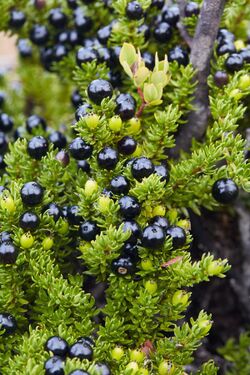Biology:Coprosma ernodeoides
| Coprosma ernodeoides | |
|---|---|

| |
| Scientific classification | |
| Kingdom: | Plantae |
| Clade: | Tracheophytes |
| Clade: | Angiosperms |
| Clade: | Eudicots |
| Clade: | Asterids |
| Order: | Gentianales |
| Family: | Rubiaceae |
| Genus: | Coprosma |
| Species: | C. ernodeoides
|
| Binomial name | |
| Coprosma ernodeoides Gray
| |
Coprosma ernodeoides, known as black-fruited coprosma in English and kūkaenēnē or ʻaiakanēnē in Hawaiian, is a sprawling shrub occurring only on the islands of Maui and Hawai‘i.[1]
Description
Coprosma ernodeoides is a prostrate shrub with narrow, shiny, tightly packed, dark-green, opposite leaves.[2] The flowers are small, and the most obviously visible features are the 8-20 mm pale style branches.[2] The distinctive shiny black fruit are 8-13 mm in diameter.[2] This is the only species of Coprosma on the Hawaiian islands with black fruit.[1]
Range
This plant is restricted to the alpine areas of Maui and Hawai‘i.[1]
Habitat
Coprosma ernodeoides inhabits a variety of open alpine sites, from lava and cinder fields to forest and shrublands.[1]
Ecology
The fruit are eaten by the nēnē.[1]
Human uses
Native Hawaiians used the fruit to make lei, the inner bark to make a yellow dye, and the fruit to make purple to black dye.[3]
Etymology
The Hawaiian name kūkaenēnē means "nēnē dung" due to the resemblance of the fruit to the feces of the nēnē, coincident with the etymology of the name of the genus Coprosma which means "smelling like dung".[1] The Hawaiian name ʻaiakanēnē means "food of the nēnē".[1]
Taxonomy
This species was described by Asa Gray in 1860 based on specimens collected by Archibald Menzies.[4][5]
References
- ↑ 1.0 1.1 1.2 1.3 1.4 1.5 1.6 Elliott, Daniela Dutra; Tamashiro, Shari Y.. "Native Plants Hawaii - Viewing Plant : Coprosma ernodeoides". University of Hawaii. http://www.nativeplants.hawaii.edu/plant/view/Coprosma_ernodeoides.
- ↑ 2.0 2.1 2.2 "Coprosma ernodeoides". Smithsonian Institution. https://naturalhistory2.si.edu/botany/hawaiianflora/speciesdescr.cfm?genus=Coprosma&species=ernodeoides.
- ↑ "Bishop Museum - Ethnobotany Database". Bishop Museum. http://data.bishopmuseum.org/ethnobotanydb/ethnobotany.php?b=d&ID=kukaenene.
- ↑ Gray, Asa (1860). "Notes upon some Rubiaceae, collected in the United States South-Sea Exploring Expedition under Captain Wilkes, with Characters of New Species, &c.". Proceedings of the American Academy of Arts and Sciences IV: 49. https://www.biodiversitylibrary.org/page/3064782.
- ↑ "Index of Botanical Specimens" (in en). The President and Fellows of Harvard College. https://kiki.huh.harvard.edu/databases/specimen_search.php?mode=details&id=167271.
Wikidata ☰ Q2996868 entry
 |

